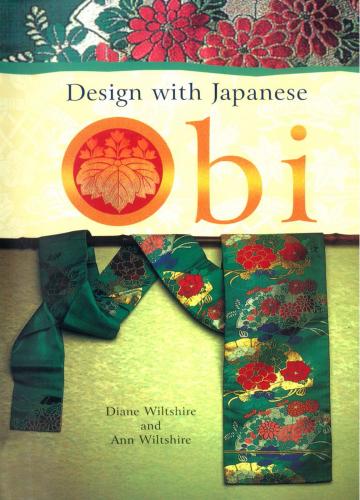In its original form, with part of the obi folded over and stitched, the Nagoya obi has a unique asymmetrical line. This seam can also be opened and the obi relined in order to achieve a longer style. If the obi is fully patterned, then it is easy to unstitch the seam, open it and reline the fabric. Before attempting this, check the folded area to see if the fabric is worn. Most obi will show a slight crease down the middle when they are opened, but, if the fabric is too worn, it will appear damaged.
If your Nagoya obi has a design on only sixty percent of the material, the plain portion can be cut out and the patterned pieces fitted together and resewn. Although this results in a shorter obi of approximately 213 cm (84.1 in.), the length is often more suitable for placing on the top of a small chest or table. Used in the original form, without relining, it is easy to knot or fold the narrow end of a Nagoya obi, whether patterned or plain, for a special touch.
Obi in the hanhaba fashion are very much in demand, due to their affordable price and narrow width of 15 cm (6 in.). This size is ideal for accenting the top of a mantel or for draping along the narrow stairs of a step chest (kaidan dansu). Another popular use for the hanhaba is as a wall hanging. The width is almost identical to that of old-fashioned "bell pulls" which hung in the homes of wealthy families, especially in the southern United States in the late nineteenth and early twentieth centuries. These bell pulls, made of elegant tapestry, were mounted with brass fittings at the top and bottom.
Seasonal colors and motifs that are so important in all aspects of Japanese life, from culture and design to food and clothing, are also evident in obi. When creating a spring table setting you may want to use an obi in soft pink shades, perhaps sprinkled with embroidered cherry blossoms. For a festive holiday look, obi in bright reds and deep greens add elegance to any interior. Dramatic autumn shades of orange and rust are also color schemes frequently found in the obi.
When buying an obi for use as a decorative accent in the home, coordinating with your interior colors is the most important consideration. Though an obi in good condition will have a higher value, the condition alone is not the most critical factor. Slight stains and worn spots will not detract from an obi in the perfect color, with an exquisite design, used in the ideal setting.
Конец ознакомительного фрагмента.
Текст предоставлен ООО «ЛитРес».
Прочитайте эту книгу целиком, купив полную легальную версию на ЛитРес.
Безопасно оплатить книгу можно банковской картой Visa, MasterCard, Maestro, со счета мобильного телефона, с платежного терминала, в салоне МТС или Связной, через PayPal, WebMoney, Яндекс.Деньги, QIWI Кошелек, бонусными картами или другим удобным Вам способом.
